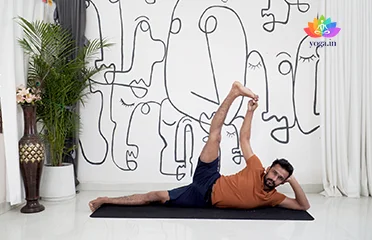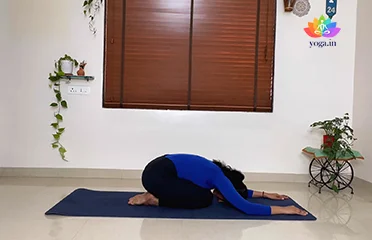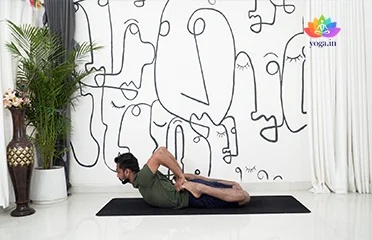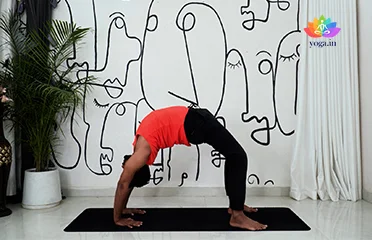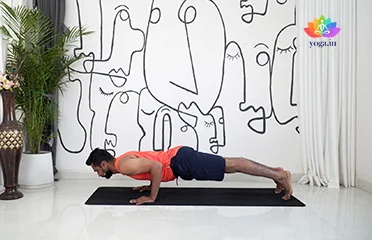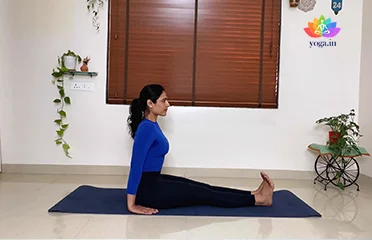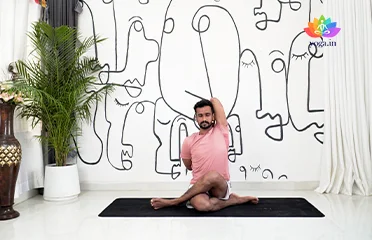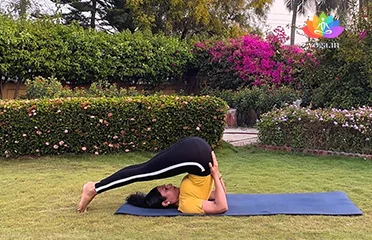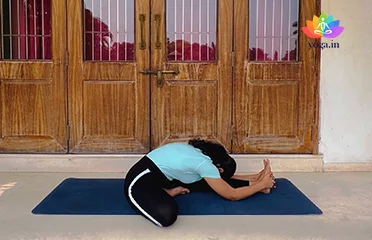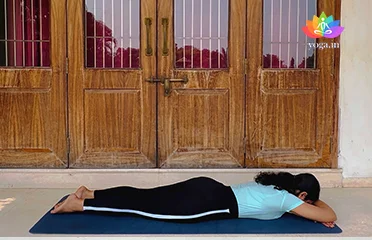Anantasana (Sleeping Vishnu Pose)
अनन्तासन / Sleeping Vishnu Pose | Vishnu's Couch Pose
The Sanskrit name is derived from Ananta (अनन्त) meaning without end [�K]
Balasana (Child’s Pose)
बालासना / Child's Pose
The Sanskrit name is derived from Bala (बाला) meaning child and āsana [�K]
Bhekasana (Frog Pose II)
भेकासन / Frog Pose II
The Sanskrit name is derived from Bheka (भेका) meaning frog and asana [�K]
Chakrasana (Wheel Pose)
चक्रासनI / Wheel Pose
The Sanskrit name is derived from Chakra (चक्रा) means wheel and asana [�K]
Chaturanga Dandasana (Low Plank Pose)
चतुरङ्ग दण्डासन / Low Plank Pose
The Sanskrit name is derived from Chatur (चतुर) meaning four, Anga (अङ्ग) [�K]
Dandasana (Stick Pose)
दण्डासन / Stick Pose
The Sanskrit name is derived from Danda (दण्डा) meaning stick and [�K]
Gomukhasana (Cow Face Pose)
गोमुखासन / Cow Face Pose
The Sanskrit name is derived from Gau (गो) meaning cow, Mukh meaning face [�K]
Halasana (Plough Pose)
हलासन / Plough Pose
The Sanskrit name is derived from Hala (हला) meaning plough and asana [�K]
Janusirsasana (Head to Knee Pose)
जानुशीर्षासन / Head to Knee Pose
The Sanskrit name is derived from (जानु) Janu means knee, Sirsa (शीर्षा) [�K]
Makarasana (Crocodile Pose)
मकरासन / Crocodile Pose
The Sanskrit name is derived from Makara (मकरा) meaning crocodile and [�K]
- 1
- 2
Yoga & Pranayama: Natural Allies for Heart Health & Blood Pressure
High blood pressure, or hypertension, is a serious condition where blood persistently pushes too forcefully against artery walls. This can lead to heart disease, stroke, and other health problems. The good news is that yoga and pranayama (yogic breathing techniques) can be powerful tools to manage and even reduce high blood pressure naturally.
Understanding the Silent Threat:
High blood pressure often has no noticeable symptoms, earning it the nickname “silent killer.” However, some people may experience headaches, dizziness, blurred vision, shortness of breath, or chest pain. If you suspect high blood pressure, it’s crucial to get checked by a healthcare professional.
Causes We Can Control:
Several lifestyle factors contribute to high blood pressure. These include:
- Unhealthy diet: Excessive salt and saturated fats can be major culprits.
- Physical inactivity: A sedentary lifestyle increases the risk of hypertension.
- Smoking and excessive alcohol: These habits put a strain on the cardiovascular system.
- Stress and anxiety: Chronic stress can lead to unhealthy blood pressure fluctuations.
Yoga and Pranayama to the Rescue:
Yoga and pranayama offer a gentle yet effective approach to managing high blood pressure. Here’s how they can help:
- Reduced Stress: Yoga’s focus on deep breathing and relaxation techniques helps manage stress hormones that can contribute to high blood pressure.
- Improved Blood Flow: Certain yoga postures can improve circulation and blood flow throughout the body.
- Weight Management: Yoga can aid in weight management, which can significantly benefit blood pressure control.
- Enhanced Self-Awareness: Yoga cultivates body awareness, which can help individuals make healthier lifestyle choices.
Supporting Your Efforts with Diet:
A balanced diet plays a crucial role in managing high blood pressure. Here are some dietary tips:
- Focus on fresh fruits and vegetables: They are rich in vitamins, minerals, and fiber, all beneficial for blood pressure regulation.
- Limit sodium intake: Reduce processed foods and opt for natural herbs and spices for flavoring.
- Embrace potassium-rich foods: Bananas, leafy greens, and sweet potatoes are excellent sources of potassium, which helps counter the effects of sodium.
- Choose lean proteins: Fish, poultry, and legumes provide essential nutrients without unhealthy fats.
- Moderate caffeine and alcohol: Excessive consumption can contribute to high blood pressure.
Important Cautions:
- Listen to your body: Start with gentle yoga practices and pranayama suitable for beginners. Avoid strenuous poses that could put undue stress on the cardiovascular system.
- Monitor regularly: Track your blood pressure regularly to assess the effectiveness of your yoga and lifestyle changes.
- Manage stress mindfully: Stress management techniques like meditation, incorporated into your yoga practice, can significantly benefit blood pressure control.
- Hydration is key: Stay well-hydrated, but limit caffeine, which can have a dehydrating effect.
- Seek professional guidance: Consult your doctor before starting any new exercise or diet regimen, especially if you have any underlying health conditions.
Who Should Be Cautious:
- Individuals with severe hypertension.
- Recent heart attack or stroke survivors.
- Pregnant women (certain poses may not be advisable).
- People with specific respiratory conditions.
A Holistic Approach for a Healthier You:
By incorporating yoga, pranayama, and a balanced diet into your life, you can take significant steps towards managing high blood pressure naturally. Remember, consistency is key. By embracing these holistic practices and working with your healthcare professional, you can empower yourself to maintain a healthy heart and optimal blood pressure for a longer, healthier life.


